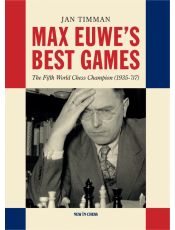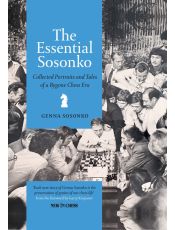
Sadler on Books (2023#5)
These book reviews by Matthew Sadler were published in New In Chess magazine 2023#5
As a child fascinated by chess history, I was – somewhat fanatically it seems to me now – always on the side of the winner. Reading through the match records of past World Championship matches, it was clear that Tarrasch and Janowsky were ‘losers’ and thus unworthy of any attention. Euwe had been a winner once, it’s true, but he’d lost again straight away so he couldn’t be a great champion. To be fair, that was the narrative that dominated the books I read, and as a child in those information-starved days, you believed pretty much everything that you read in books. It was a great shame, as it blinded me for years to the games of some wonderful players from whom I could have learnt so much. For me, that gap is finally being filled in adulthood as we are treated to serious and balanced appraisals of the many wonderful players chess history has seen. There could be no better player than Jan Timman to perform this task for the 5th World Champion, Dutchman Max Euwe.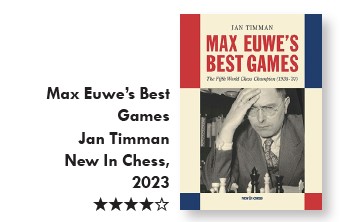 In Max Euwe’s Best Games (New In Chess) Timman analyses 80 of Euwe’s games, starting with a famous 1920 ‘Hypermodern’ (double fianchetto) victory over Richard Réti, no less, and ending with the better of a draw against Genna Sosonko in 1975, with the bulk of the games played before the start of the Second World War in 1939.
In Max Euwe’s Best Games (New In Chess) Timman analyses 80 of Euwe’s games, starting with a famous 1920 ‘Hypermodern’ (double fianchetto) victory over Richard Réti, no less, and ending with the better of a draw against Genna Sosonko in 1975, with the bulk of the games played before the start of the Second World War in 1939.
Annotating classic games is a special skill. Playing through the games in all the game collections I reviewed this month, I was frequently awed by the maximum strength of classic players – in their best games playing chess that far transcended the chess knowledge of their time. At the same time, they played periods of some games at a – from a modern perspective – sub-standard level. I think that Timman always approaches this superbly, balancing the critical eye of the modern player (aided by the engine) with compassion for the era in which these games were played. With the eye of a practical player, he also unearths themes and mannerisms in Euwe’s play – for example a tendency to convert winning positions by exchanging into endgames rather than finishing off in the middlegame – which brings Euwe’s play alive for the modern reader.
I’d like to show the fine end to a slightly uneven – and for me unknown – game against Belgian player Edgard Colle. It features a remarkable tactical conclusion:
Max Euwe
Edgard Colle
Amsterdam 3rd match game 1928
Nimzo-Indian Defence, Classical Variation
1.d4 ♘f6 2.c4 e6 3.♘c3 ♗b4 4.a3 ♗xc3+ 5.bxc3 0-0 6.♕c2 d5 7.cxd5 exd5 8.♗g5 ♕d6 9.e3 b6 10.♘f3 ♗b7 11.♗d3 h6 12.♗xf6 ♕xf6 13.♘e5 c5 14.♕a4 ♕d6 15.0-0 ♘c6 16.f4 f6 17.♘g6 ♖f7 18.♗b1 ♘e7 19.♕c2 ♕e6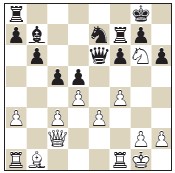 Timman commented that Euwe loved his queen and bishop batteries and he wondered whether Euwe had seen the final finishing blow already when he was setting up the queen and bishop with 18.♗b1 and 19.♕c2.
Timman commented that Euwe loved his queen and bishop batteries and he wondered whether Euwe had seen the final finishing blow already when he was setting up the queen and bishop with 18.♗b1 and 19.♕c2.
20.♘h8 A fantastic idea!
20...♕xe3+ 20...♖ff8 21.♕h7 is a beautiful mate.
21.♔h1 cxd4 22.♕h7+ ♔f8 23.♗g6 ♘xg6 24.♘xg6+ ♔e8 25.♕g8+ Black resigned.
The key move 20.♘h8!! appealed to me particularly because in the 2020 Online British Championship, I awarded the Best Game Prize to Tristan Cox for this magnificent finish against Tom O’Gorman:
Tristan Cox (2141)
Tom O’Gorman (2368)
Benko Gambit
Caplin British Online 2020
1.d4 ♘f6 2.c4 c5 3.d5 b5 4.cxb5 a6 5.e3 axb5 6.♗xb5 ♕a5+ 7.♘c3 ♗b7 8.♗d2 ♕b6 9.♘f3 ♘xd5 10.a4 e6 11.0-0 ♗e7 12.e4 ♘xc3 13.♗xc3 f6 14.♘h4 0-0 15.♕g4 ♗a6 16.♗xa6 ♕xa6 17.f4 ♘c6 18.♖f3 ♕c4 19.♖e1 ♘d4 20.♖g3 ♖f7 21.f5 ♖xa4 22.♕h5 ♕a6 23.♗xd4 cxd4 24.♘g6 h6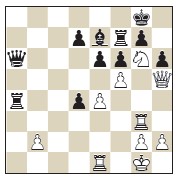 25.♘h8 1-0.
25.♘h8 1-0.
Black resigned in view of 25...♖f8 26.♕xh6 or 25...♔xh8 26.♕xf7.
I was commentating live on this game, and I’m glad I managed to shout out ♘h8 just before Tristan played it, thus saving my commentator’s honour! At the time I commented that I had never seen such a finish before... I should have done!
Yet another excellent and enjoyable book from Jan – 4 stars!
***
And finally, we end with the big one – literally! To celebrate Genna Sosonko’s 80th birthday, New In Chess has brought together the portraits and profiles that Genna wrote for New In Chess Magazine, some excerpts from some of his books and some additional material, interspersed with a series of photos, in a colossal hardback volume of over 800 pages!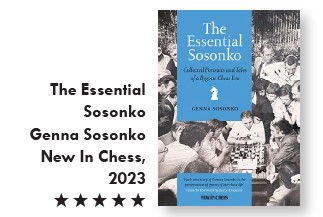 Perhaps my biggest regret when reading Genna’s wonderful writings is that Genna isn’t a bit older! Just 30 or 40 years extra, and he could have talked with Lasker and Alekhine and Tarrasch... There is a relentless process of time through which classic players fade away into the database, falling from sight as their openings lose relevance, their games pushed to the bottom of any searches, far below the place even the most assiduous of students would scroll down to! Genna’s profiles of players like Bronstein and Tal keep some link alive to the people behind the moves, and by doing so – for me at least – keep their games alive too. When you have such a personal account of these great players’ mentality, their attitudes in life, their lifestyles, their obsessions, their misdemeanours and their (mis)judgements, you can’t help but see their games in a richer and more vibrant light.
Perhaps my biggest regret when reading Genna’s wonderful writings is that Genna isn’t a bit older! Just 30 or 40 years extra, and he could have talked with Lasker and Alekhine and Tarrasch... There is a relentless process of time through which classic players fade away into the database, falling from sight as their openings lose relevance, their games pushed to the bottom of any searches, far below the place even the most assiduous of students would scroll down to! Genna’s profiles of players like Bronstein and Tal keep some link alive to the people behind the moves, and by doing so – for me at least – keep their games alive too. When you have such a personal account of these great players’ mentality, their attitudes in life, their lifestyles, their obsessions, their misdemeanours and their (mis)judgements, you can’t help but see their games in a richer and more vibrant light.
Everyone will have their favourites – strangely I thought I knew what my favourites were until I started reading the book again and everything changed. I guess the state of the reader shapes the book as well. During a period of worrying about my parents a couple of years ago, I was greatly moved by Sosonko’s account of the last years of Smyslov and his wife. This time, Sosonko’s recollections of Alvis Vitolins resonated with me. The account that makes me smile every time I read it is the interview with Olga Clark, Capablanca’s wife. It’s strange and funny to see how all the things you find desperately important about Capablanca as a chess player were exactly the things that were of no importance whatsoever to his wife! And perhaps rightly so!
I’ve always wanted a book I could give to non-chess players to explain why chess can fascinate you all your life, and why and how a life in chess is way more than just moves and openings. I think I’ve found it! 5
stars!

